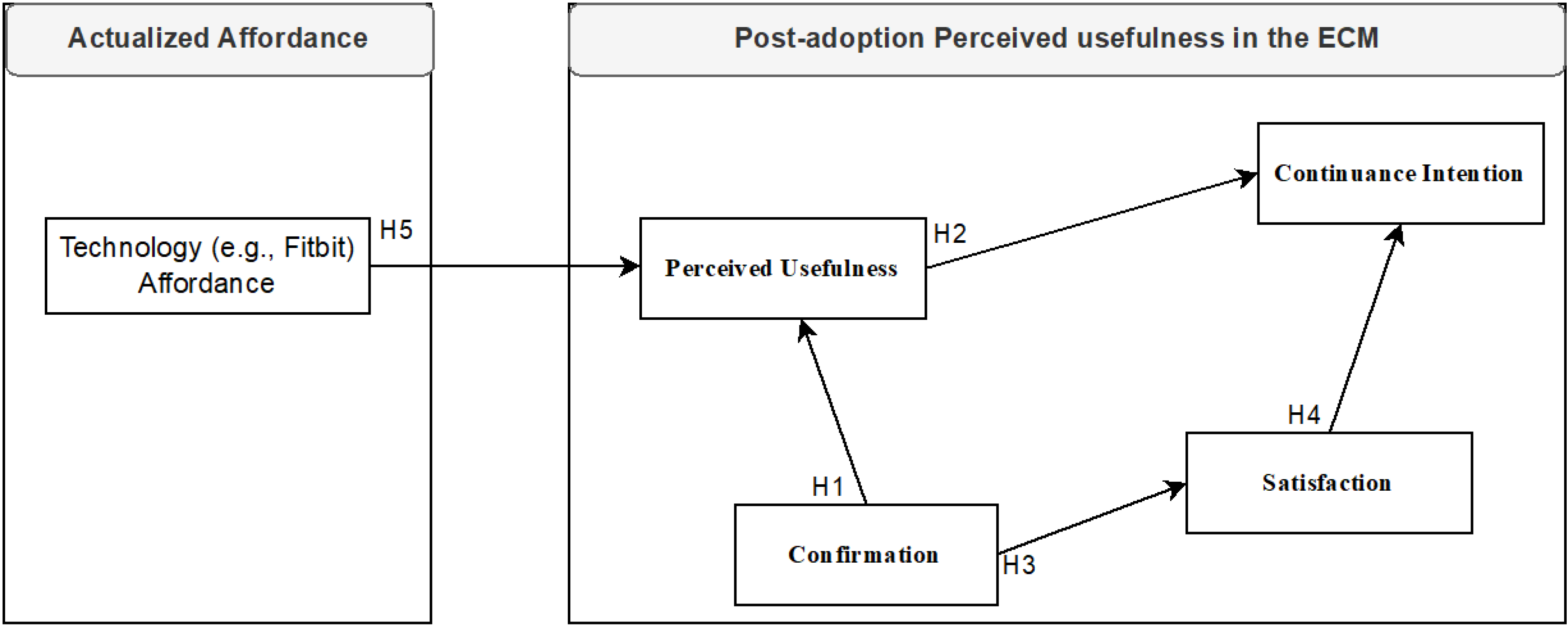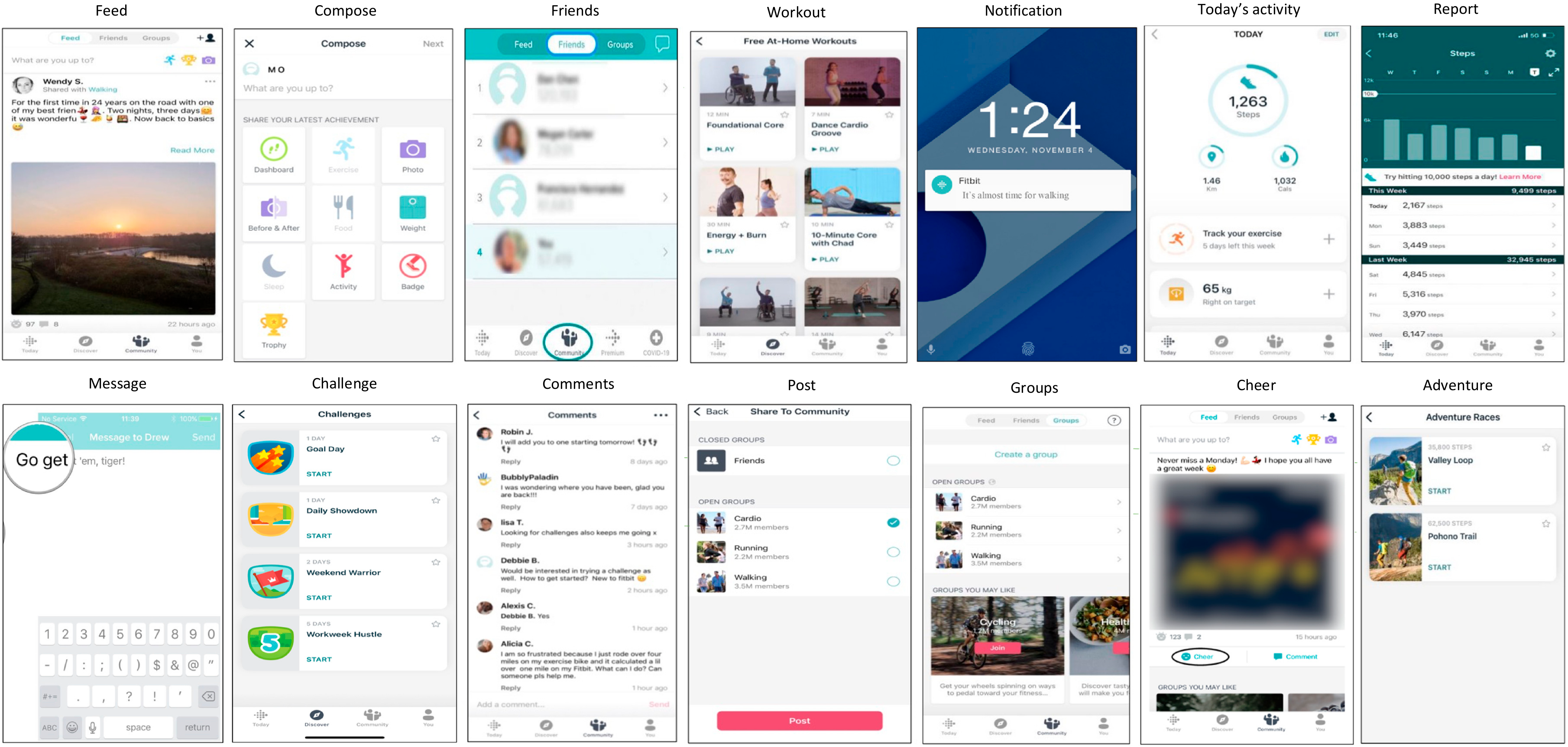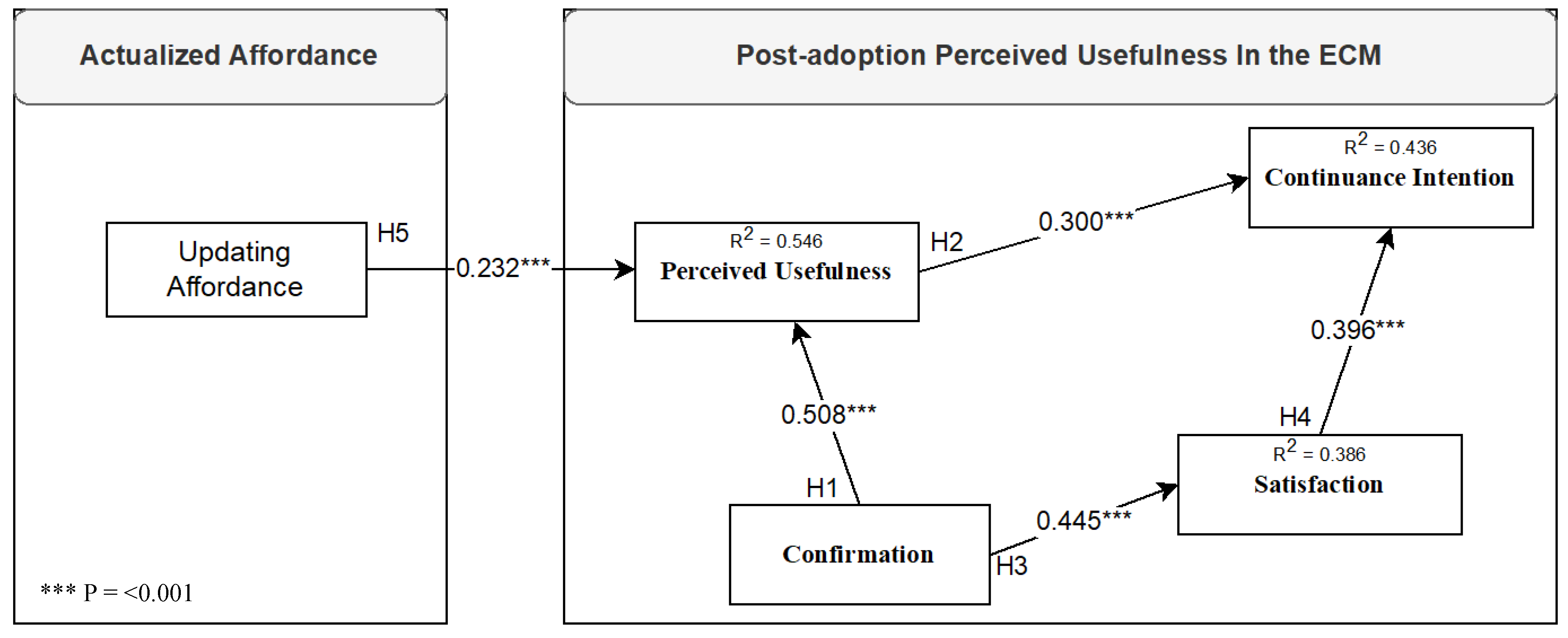1. Introduction
Post-adoption or usage behaviors, such as continuance of information technology (IT) use, have been a phenomenon of constant interest in information systems (IS) research [
1,
2,
3,
4,
5]. IT continuance is described as “users’ decisions to continue using an IT over the long run” [
1]. Various IS theories and models have been developed to uncover factors influencing IT continuance [
3,
5,
6,
7,
8,
9,
10,
11,
12]. These theories and models have been applied in research targeting different contexts among various populations with an aim to understand the involved phenomena broadly [
6,
7,
8,
9,
10].
Among the various developed theoretical models, the Expectation Confirmation Model (ECM) was one of the earliest accepted theoretical models explaining the essential influences on users’ continuing to use technology [
5,
13,
14]. The ECM posits that users’ confirmation of what is expected while using technology impacts their perception of the technology usefulness and their satisfaction [
6]. Users’ perceptions of the technology’s usefulness and their satisfaction directly impact their intention to continue using it [
6]. Although the original ECM study and its early adopters validated the framework through systems that have since become essential in modern life, such as organizational work systems and online banking [
3,
6], the model remains relevant for understanding user adoption of emerging technologies that have potential to enhance quality of life such as personal finance apps and mobile health apps but are not mandatory or essential to daily tasks. Without users’ continued use, these optional technologies would not be able to deliver their primary intended purpose [
15]. Hence, studying factors impacting continued use in a context where use is optional and benefits are dependent on the continuation of use is important.
Perceived usefulness represents users’ belief that a technology enhances their performance [
1,
6]. Perceived usefulness, a key construct in ECM, has been consistently shown to have a significant influence on users’ decisions to continue using technologies [
4,
16,
17,
18,
19,
20,
21,
22]. Research confirms that perceived usefulness exerts enduring effects on IT continuance, as it constitutes “a long-term, transaction-invariant belief” [
6]. Given its critical role, a deeper examination of how users perceive post-adoption usefulness is necessary to enhance our understanding of IT continuance. McGrenere and Ho [
23]’s conceptualization of usefulness provides valuable insight, suggesting that “the usefulness of a design is determined by what the design affords (that is, the possibilities for action in the design) and whether these affordances match the goals of the user and allow the necessary work to be accomplished” (p. 6). This perspective aligns with the Strong–Volkoff [
24] framework, where affordances emerge from both (1) potentials for action within the technology and (2) users’ actualization of those potentials through their interactions with the technology.
During post-adoption, Bhattacherjee [
6] distinguishes user expectations from their confirmation, arguing that users may feel tension when their pre-adoption perceptions have not been met. Users may then adjust their usefulness perceptions to align with reality, with confirmation elevating perceived usefulness and disconfirmation reducing it. Thus, the confirmation of expectations influences users’ perception of the technology’s usefulness because it transforms users’ expectations into reality. We argue that, during post-adoption, actualized affordances represent what the technology can offer to users based on their goals and hence explain their perception of usefulness.
In the post-adoption phase, the relationship between expectation confirmation and perceived usefulness is broader than that between actualized affordances and perceived usefulness. Originating from consumers’ post-purchase evaluations of expectation–experience discrepancies [
25,
26], expectation confirmation operates at multiple levels, assessing IT attributes (e.g., system design and usability) and user attributes (e.g., personal benefits and attitudes) [
1,
6,
27,
28,
29]. In contrast, actualized affordances focus narrowly on how users utilize the technology to achieve specific goals [
24]. Thus, while expectation confirmation reflects overarching drivers of post-adoption perceived usefulness, affordance actualization demonstrates its concrete, task-level operationalization, highlighting the distinction between broad evaluative judgments and goal-directed utility in practice. Addressing how technology affordances, beyond mere forms and functions, influence IT continuance represents a critical gap in the literature, as highlighted by Yan and Filieri [
13]. This study advances ECM by incorporating affordance actualization to explain how users come to perceive a technology as useful in the post-adoption phase, a nuance that is overlooked by prior ECM-focused research. These insights lead to our research questions: How does actualization of technology affordances influence perceptions of usefulness and hence continuance intention?
This study seeks to address its research question within the context of fitness apps. Specifically, it explores how users of fitness apps perceive their usefulness through actualizing the apps’ affordances, leading them to continue using the apps. Fitness apps, like Fitbit, offer personalized activity guidance, reports, and a supportive community to enhance exercise efficiency and health awareness [
15,
30]. Despite being the most downloaded health apps in the US [
31], with 17 million active users in 2021 [
32] and a projected market of USD 14.64 billion by 2027 [
33,
34], fitness apps’ success hinges on sustained user engagement facilitated by continued use. Many users abandon these apps shortly after downloading or within months [
35,
36], making them an ideal case for studying the post-adoption perceived usefulness phenomenon in IT.
4. Data Analysis
We used the Qualtrics data and analysis tab that enables filtering, classifying, merging, cleaning, and statistically analyzing the response data to investigate participant ratings of the usefulness of each Fitbit feature and the purposes for which participants utilized each feature. Although the survey included items for 11 affordances, only the most actualized affordance was included in the final SEM analysis to minimize model complexity and reflect dominant user behavior to help us understand how the actualized affordance influences users’ perceived usefulness. The most actualized affordance was determined based on the most common purpose for use selected by the users.
Next, the study data were analyzed using covariance-based structural equation modeling (CB-SEM), a robust method for examining and quantifying relationships between variables, particularly in complex models like the one employed in this study [
75]. To implement SEM, we followed the two-step approach outlined by Anderson and Gerbing [
75]. The initial step involved evaluating the reliability and validity of the measurement scales to ensure the robustness of the measurement instruments. To that end, we employed confirmatory factor analysis (CFA) using maximum likelihood (ML) estimation to evaluate reliability and convergent and discriminant validity. We examined factor loadings, Cronbach’s alpha, average variance extracted (AVE), and the Heterotrait–Monotrait (HTMT) ratio of correlations for discriminant validity, and the variance inflation factor (VIF) for multicollinearity. Following the scale reliability and validity assessments, we tested the model fit. This involved assessing the appropriateness of the measurement model using various indices, including the comparative fit index (CFI), the Tucker and Lewis index (TLI), the root mean square error of approximation (RMSEA), and Mardia’s multivariate normality test.
6. Discussion
Given its role in confirming the value of systems and applications, IS researchers have investigated post-adoption behaviors like the continuation of technology use, with perceived usefulness defined as the most salient post-adoption attitude related to IT continuance [
1]. Research on IT continuance has investigated how factors such as ease of use [
16,
17,
20,
21,
22], trust [
18,
19], attitude [
17], and site quality [
19] influence post-adoption perceived usefulness. While these factors contribute to shaping users’ perceptions of technology usefulness, they do not fully explain the mechanisms through which these perceptions emerge.
Drawing on affordance actualization theory [
23,
24,
67], this study argues that post-adoption perceived usefulness is directly influenced by the actualization of affordances through the use of technology features. In other words, the extent to which users perceive a technology as useful depends on the affordances they actualize when interacting with its features. This perspective offers a more nuanced understanding of IT continuance, moving beyond forms and functions to consider how perceived usefulness emerges from user–system interactions [
13]. By adopting a systemic lens, this study underscores the importance of understanding user behavior as an outcome of interrelated components, users with varying goals and technology features with diverse functionalities, working within a coherent sociotechnical system to shape technology affordances.
This study examined Fitbit users’ engagement with various features and the affordances they actualized. Our findings highlight that exercise status updating was the most frequently actualized affordance. As a result, the updating affordance was incorporated into the ECM to evaluate its impact on perceived usefulness. The revised model explains approximately 43% of the variance in continuance intention, surpassing the baseline IS continuance model (41%) proposed by Bhattacherjee [
6]. This slight increment underscores the importance of actualized affordance (updating) as a key determinant of perceived usefulness.
The model results also explain about 54% of the variance in perceived usefulness shared with the original ECM variable, expectation of confirmation. The expectation of confirmation influence on perceived usefulness is stronger in our model because expectation of confirmation is driven by users’ assessment of all possible IT attributes (e.g., Fitbit design and available support and assistance) that could vary based on users’ attributes (e.g., preference of the design and need for the support and assistance). In contrast, actualized affordances (updating) focus narrowly on how users utilize the technology to achieve specific goals. Furthermore, this study treats actualized affordances as integral to users’ confirmation of expectations rather than as a basis for direct comparison. Users may expect what a technology could possibly afford, along with other expectations. However, these expectations, involved with technology affordance, do not formatively explain perceived usefulness; instead, they only influence it. For instance, technical support for a technology does not inherently explain perceived usefulness, as users do not adopt a technology primarily to receive support. Instead, they use it to fulfill core goals (e.g., to be updated about their exercise status). While technical support may facilitate meeting users’ goals when issues arise, it does not determine the purpose of using a technology and hence its usefulness. Thus, actualized affordances offer a more direct explanation of perceived usefulness, unlike factors such as support expectations, which only indirectly shape it without providing a definitive account. Users hold diverse expectations regarding design and usability, each defined differently, yet none alone explain perceived usefulness.
While previous studies have made important contributions by identifying the broad range of affordances that fitness apps can offer [
62,
63,
64,
65,
66], they often do not examine the extent to which these affordances are actualized by users. Building on this foundation, our analysis of feature usage patterns reveals that affordance actualization varies across participants. Specifically, our findings suggest that Fitbit’s perceived usefulness and continued usage are primarily shaped by three core affordances: (1) providing most users with updates on their exercise status, (2) reminding a subset of users to stay active, and (3) guiding a smaller group in their exercise routines. These results highlight the value of moving beyond potential affordances to understand which ones are most influential in driving perceived usefulness, offering deeper insights into IT continuance within the fitness app context.
Affordance theory posits that technology design offers possibilities for action, but these must align with user goals to be meaningful [
23]. Our study demonstrates that when users actualize the updating affordance, their perception of Fitbit’s usefulness is significantly influenced. By introducing actualized affordance as a critical factor in post-adoption perceived usefulness, this research contributes to the theoretical discourse on IT continuance.
Beyond theoretical implications, these insights offer valuable guidance for technology design. This study underscores the importance of understanding how users actualize affordances through specific features. For instance, updating was primarily actualized through the “Today’s Activity” and “Report” features. This finding suggests that technology designers should explore affordance actualization patterns to identify the key benefits users derive from specific features. Failure to recognize these core advantages may lead to misguided feature enhancements, resulting in redundant or underutilized functionalities.
Moreover, not all features were perceived as useful for exercising. While “Report” and “Today’s Activity” were rated highly, features such as “Adventure,” “Post,” “Comments,” “Feed,” and “Message” were rated lower and rarely used. This suggests that users selectively engage with features that facilitate the actualization of needed affordances. For example, the majority of participants used “Report” and “Today’s Activity” to actualize updating. The observed variability in feature usage also suggests that users have diverse preferences, reinforcing the need for customization options that cater to different needs. From a system design perspective, these findings highlight the importance of affordance-centered feature design. Designers should prioritize the integration and visibility of features that support core user goals, such as updating, while also allowing for personalization and adaptive interfaces that can dynamically surface features aligned with individual usage patterns. In doing so, developers can create more responsive and engaging systems that enhance perceived usefulness and support sustained user engagement.
Overall, this study reinforces the critical role of affordance actualization in shaping perceived usefulness and IT continuance. By identifying which affordances users actualize and through which features, technology designers can develop systems that better align with user needs, ultimately enhancing both adoption and long-term engagement. Future research should explore affordance actualization in other technological contexts to further refine our understanding of IT continuance dynamics.
7. Limitations and Future Research
While both confirmation and affordance actualization operate post-adoption, they reflect distinct mechanisms: confirmation evaluates whether prior expectations were met [
6], whereas actualization captures emergent behaviors that shape usefulness perceptions through feature engagement [
24]. This suggests that affordance actualization may mediate the link between confirmation and perceived usefulness. This creates a possibility for future research to test with longitudinal behavioral data.
This study examined the impact of affordance actualization on user perceptions of app usefulness, focusing specifically on fitness app affordances that were identified and measured using specific items. However, there are affordances that remain uncovered or that lack measurable items. Future studies can build on the theoretical base of this study to investigate the impact of other affordances on user perceptions of app usefulness. Adding more actualized affordances may increase the variance explained in perceived usefulness. This would contribute to a more comprehensive understanding of the relationship between affordance actualization and user perceptions in the context of fitness apps.
We treated affordances as if they all exist at the same level, implying that users can directly actualize any of them using the app’s features. However, this implication of equality among affordances may not be accurate. Volkoff and Strong [
80] elucidated the granularity levels for affordance actualization, proposing that the actualization of one affordance may pave the way for the actualization of another. Our study did not explore whether actualizing one affordance, such as reminding, might lead to the actualization of another, like updating status. So, users might be reminded first, then updated, and vice versa. Further research could examine the sequential processes users undergo that ultimately contribute to the perceived usefulness of the technology.
While this study investigates how users perceive the usefulness of technology through the actualization of affordances, it does not examine how the actualization of different affordances may vary across user groups. For example, younger users might be more inclined to actualize social-related affordances such as “sharing” or “competing,” whereas older users may prioritize features that support tracking and goal-setting. Future research could explore how demographic or psychographic differences influence affordance actualization to better tailor technology design to diverse user needs.
This study focused on Fitbit. However, different fitness apps have distinct designs and feature sets. These variations in technology design can influence perceptions of technology usefulness. Future research could explore a broader range of fitness apps, consider the design differences, and assess how the variations impact perceptions and experience.








